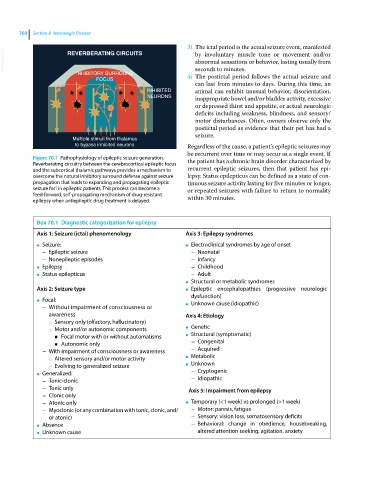Page 792 - Clinical Small Animal Internal Medicine
P. 792
760 Section 8 Neurologic Disease
3) The ictal period is the actual seizure event, manifested
VetBooks.ir by involuntary muscle tone or movement and/or
REVERBERATING CIRCUITS
abnormal sensations or behavior, lasting usually from
seconds to minutes.
INHIBITORY SURROUND 4) The postictal period follows the actual seizure and
FOCUS
can last from minutes to days. During this time, an
INHIBITED animal can exhibit unusual behavior, disorientation,
NEURONS inappropriate bowel and/or bladder activity, excessive
or depressed thirst and appetite, or actual neurologic
deficits including weakness, blindness, and sensory/
motor disturbances. Often, owners observe only the
postictal period as evidence that their pet has had a
seizure.
Multiple stimuli from thalamus
to bypass inhibited neurons Regardless of the cause, a patient’s epileptic seizures may
be recurrent over time or may occur as a single event. If
Figure 70.1 Pathophysiology of epileptic seizure generation. the patient has a chronic brain disorder characterized by
Reverberating circuitry between the cerebrocortical epileptic focus
and the subcortical thalamic pathways provides a mechanism to recurrent epileptic seizures, then that patient has epi-
overcome the natural inhibitory surround defense against seizure lepsy. Status epilepticus can be defined as a state of con-
propagation that leads to expanding and propagating epileptic tinuous seizure activity lasting for five minutes or longer,
seizure foci in epileptic patients. This process can become a or repeated seizures with failure to return to normality
feed‐forward, self‐propagating mechanism of drug‐resistant within 30 minutes.
epilepsy when antiepileptic drug treatment is delayed.
Box 70.1 Diagnostic categorization for epilepsy
Axis 1: Seizure (ictal) phenomenology Axis 3: Epilepsy syndromes
Seizure: Electroclinical syndromes by age of onset
● ●
– Epileptic seizure – Neonatal
– Nonepileptic episodes – Infancy
Epilepsy – Childhood
●
Status epilepticus – Adult
●
Structural or metabolic syndromes
●
Axis 2: Seizure type ● Epileptic encephalopathies (progressive neurologic
dysfunction)
Focal:
● Unknown cause (idiopathic)
– Without impairment of consciousness or ●
awareness Axis 4: Etiology
○ Sensory only (olfactory, hallucinatory) Genetic
○ Motor and/or autonomic components ●
▪ Focal motor with or without automatisms ● Structural (symptomatic)
▪ Autonomic only – Congenital
– With impairment of consciousness or awareness – Acquired
○ Altered sensory and/or motor activity ● Metabolic
Unknown
○ Evolving to generalized seizure ●
Generalized: – Cryptogenic
●
– Tonic‐clonic – Idiopathic
– Tonic only Axis 5: Impairment from epilepsy
– Clonic only
– Atonic only ● Temporary (<1 week) vs prolonged (>1 week)
– Myoclonic (or any combination with tonic, clonic, and/ – Motor: paresis, fatigue
or atonic) – Sensory: vision loss, somatosensory deficits
Absence – Behavioral: change in obedience, housebreaking,
●
Unknown cause altered attention seeking, agitation, anxiety
●

